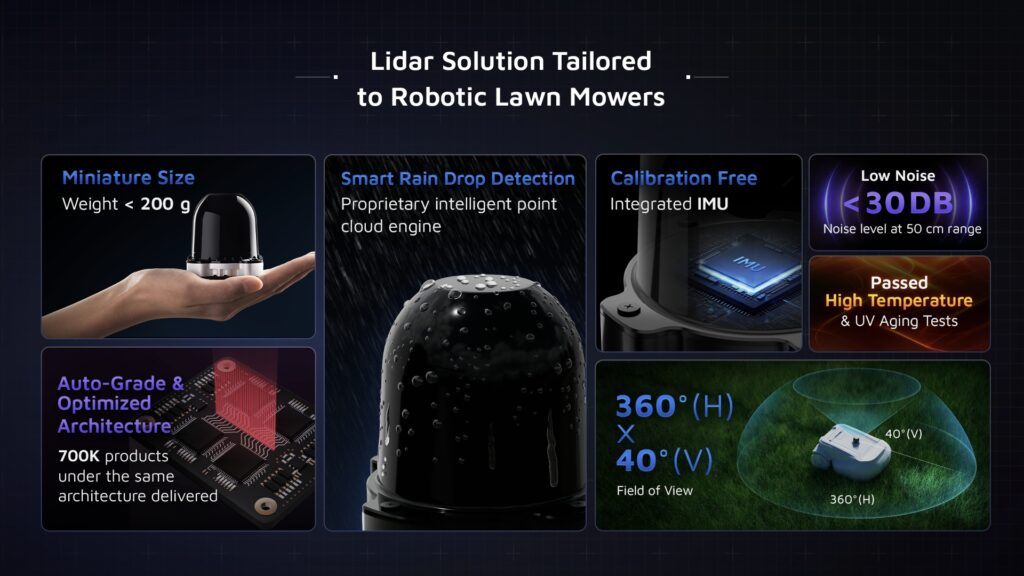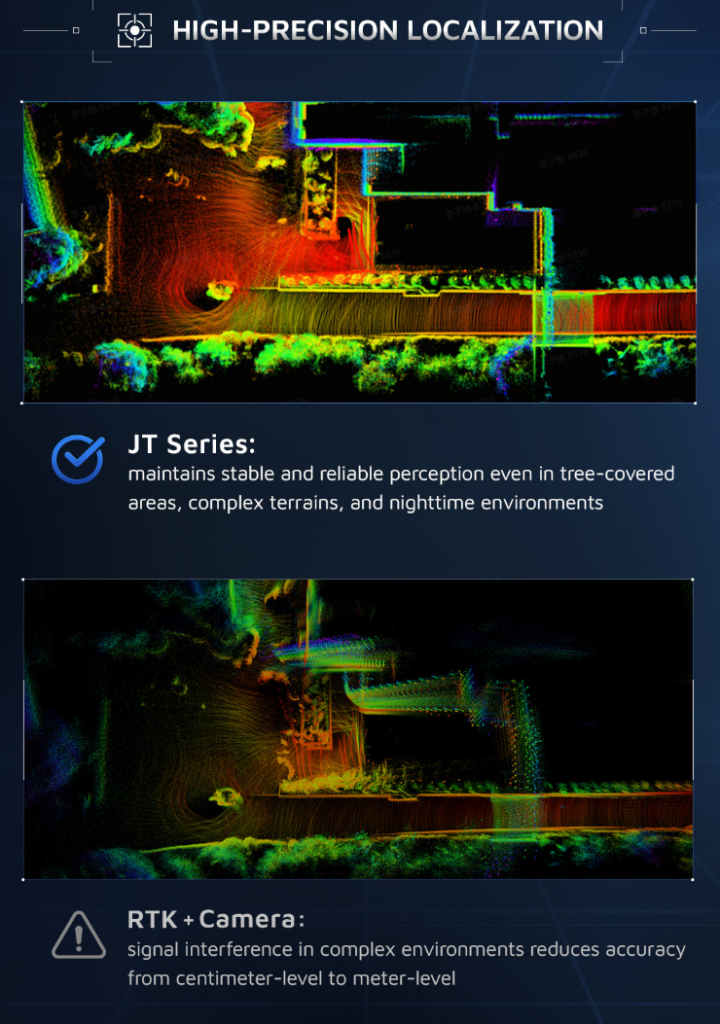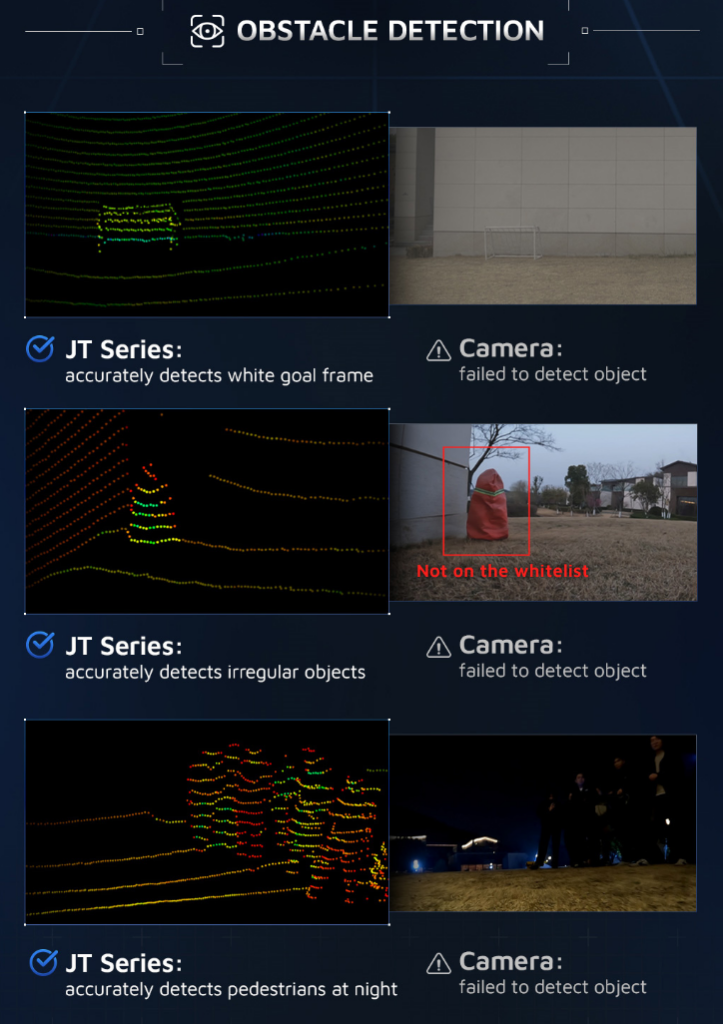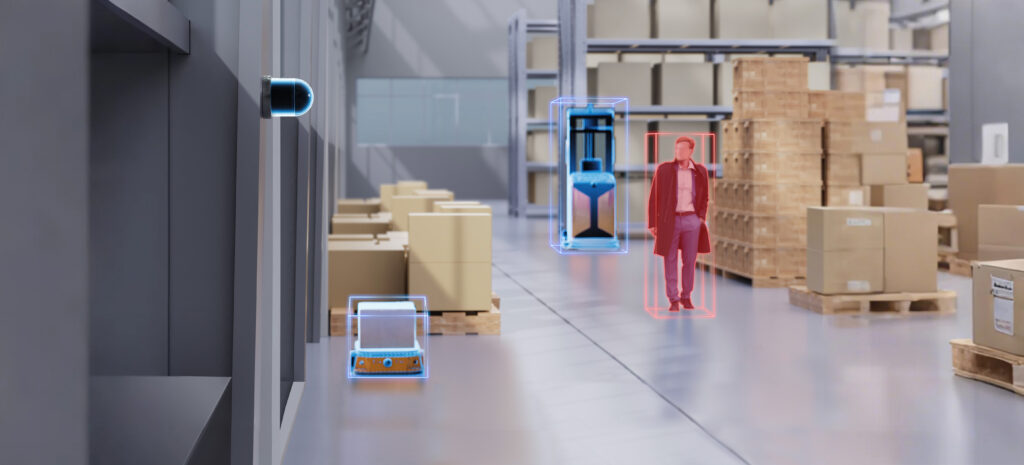
No Wires, No Hassle: How Lidar Unlocks True Intelligence in Robotic Lawn Mowers
With AI algorithms and sensing hardware evolving rapidly, lawn mowers have undergone a dramatic transformation—from manual tools to intelligent devices. According to Fortune Business Insights, the global robotic lawn mower market is projected to grow from 1.48 billion USD in 2021 to 4.04 billion USD by 2028. At CES and MWC 2025, brands like Dreame, Segway-Ninebot, Husqvarna, Greenworks, and Mowrator unveiled their latest advancements in smart robotic lawn mowers. These robots are rapidly gaining popularity thanks to features such as automation, remote control, and energy efficiency.
Despite these advancements, key technological challenges persist: how can we eliminate the hassle of manual base station deployment, mitigate signal interference, and ensure real-time obstacle detection and avoidance in complex outdoor environments?

JT Series Lidar: Advanced Perception Technology Designed for Robotic Lawn Mowers
By leveraging its expertise in lidar solutions, Hesai has introduced the JT series lidar. The JT series is a mini 3D lidar tailored to the robotic market, weighing only around 200 grams. It’s 75% lighter than similar lidar sensors on the market, making it easy to integrate into small home service robots. This reduction in weight enhances agility, lowers energy consumption, and extends battery life—critical attributes for robotic lawn mowers that demand both efficiency and flexibility.
Powered by Hesai’s second-generation lidar architecture, the JT series benefits from extensive field validation, with over 700,000 units already delivered. It offers a 30-meter detection range (@10% reflectivity) and features a 360° horizontal and 40° vertical field of view, enabling omnidirectional sensing for precise mapping, positioning, and obstacle avoidance in challenging outdoor settings.
Designed for all-weather operation, the JT series is equipped with intelligent rain detection feature, which eliminates the need for additional rain sensors. It has gone through rigorous testing, including 1,500 hours of high-temperature tests, UV aging tests, ensuring reliability even under extreme conditions.

Lidar vs. RTK + Camera: Which is the Better Choice for Smart Robotic Lawn Mowers?
Traditional robotic lawn mowers rely on RTK (Real-Time Kinematic) positioning and camera-based vision systems for navigation. While effective in some scenarios, these technologies have limitations:
- Signal Interference: RTK systems depend on satellite signals, which can be disrupted by buildings, trees, and weather conditions.
- Obstacle Detection: Camera-based solutions struggle with irregular objects, lighting variations, and poor visibility at night.
Lidar technology overcomes these limitations, providing superior 3D perception and adaptability in diverse environments. Here’s how:
Efficient, Accurate Perception
Unlike RTK + camera solutions, which require pre-installed infrastructure and are limited to 2D mapping, 3D lidar with SLAM (Simultaneous Localization and Mapping) technology delivers high-precision 3D mapping. This enables fully autonomous path planning without labor-intensive base station installations.
Field tests show that JT series-equipped robotic lawn mowers can generate a complete 1,000㎡ map in just 3.5 minutes, significantly reducing setup time and costs.

High-Precision Positioning
Lidar’s centimeter-level accuracy ensures stable, boundary-free navigation, even in complex landscapes. In contrast, RTK + camera-based systems experience signal degradation in urban settings and at night, reducing precision to meter-level accuracy.
JT series’s SLAM technology delivers a measured wall thickness accuracy of 4.58 cm, maintaining high precision even when navigating around trees, garden furniture, or uneven terrain.

Omnidirectional Dynamic Obstacle Avoidance
Lidar’s active 3D distance measurement is unaffected by ambient lighting. Whether operating at night or identifying unfamiliar or similarly colored objects, the JT Series delivers accurate real-time detection, helping mowers adapt quickly and navigate safely. On the other hand, RTK + camera setups are vulnerable to poor lighting conditions, leading to decreased obstacle recognition and potential safety risks.

JT Series: Accelerating the Future of Consumer Robotics
In 2025, Hesai’s JT series is expected to reach six-figure order volumes for MOVA’s smart robotic lawn mowers.
Li Fei, Head of MOVA’s Global Lawn Mower Division, highlights, “With its compact size and lightweight design, the JT series seamlessly integrates with the MOVA 600 and MOVA 1000, enhancing their perception accuracy and operational efficiency—key attributes valued by consumers worldwide.”
Lidar has became the critical sensor for robotic applications. The shift from 2D to 3D sensing is redefining performance standards in garden robotics, ushering in a new era of all-weather, all-terrain smart home ecosystems.



